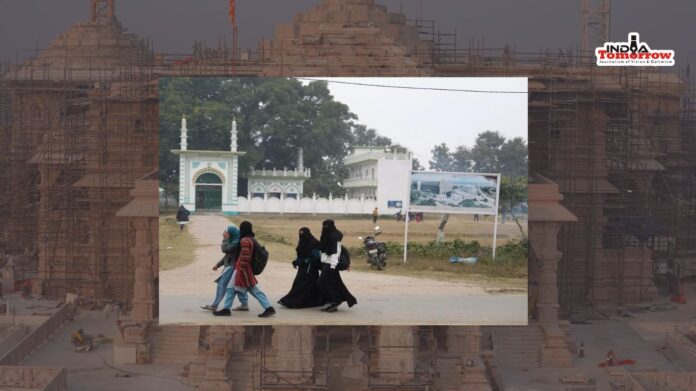By Our Correspondent
NEW DELHI – A sense of fear has engulfed Muslims in Ayodhya ahead of the Ram temple consecration set to take place on January 22 and being touted as a momentous occasion giving a new direction to India away from the constitutional principles of secularism and equality of all citizens. Muslim residents in Ayodhya town, like the entire community in northern India, are worried about their safety amid the frenzy building up around the temple.
Since Ayodhya will witness the influx of thousands of devotees on the day of ‘Pran Pratishtha’ (consecration), there are legitimate fears about communal violence on the pattern witnessed in the aftermath of the demolition of Babri Masjid in 1992. The anxiety of local Muslims is growing as the countdown for January 22 gets closer.
Though the administration has assured the residents of the town that it will maintain peace and security in the area on the date of the consecration ceremony and afterwards, Muslims are apprehensive and have sent the women and children in their families to other cities to stay with their relatives for some time. A local Muslim organisation has submitted a petition to the authorities demanding strict vigil in the localities with sizeable Muslim populations.
There are about 5,000 Muslims in a four-km radius around the land plot where the grand temple is coming up. In Ayodhya district, 14.8% of the nearly 25 lakh inhabitants are Muslims. Mohammed Azam Qadri, president of the Sunni Central Waqf Board sub-committee in Ayodhya, says that the fear of 1990 and 1992 communal incidents is difficult to forget for many people.
“Hindus and Muslims have lived in peace in Ayodhya town, but in the past, due to mobs of outsiders at various events, the Muslim community has suffered loss of life, property and religious places. From January 22, after inauguration of the Ram temple, it is estimated that a large crowd of outsiders are slated to visit Ayodhya,” reads a January 16 letter by the Anjuman Muhafiz Masajid-wa Maqabir, an organisation of local Muslims, addressed to the Inspector General of police, Ayodhya division.
The letter stated that Muslims residing in Ayodhya were fearful of life, property and religious places. “In view of previous experiences, we request for strict vigil and security in localities like Terhi Bazar, beside Teen Wali Masjid, Gol Chauraha Sayyadbara, Begumpura, Durahi Kuan, Mughalpura, among others,” it said. Muslim residents do not fear their Hindu neighbours, but among the lakhs of people from outside, some elements may have different motives.
A special task force of the Uttar Pradesh Police will provide a comprehensive security cover to the upcoming temple complex, while the Central Industrial Security Force has taken charge of security at the newly inaugurated Ayodhya airport, deploying more than 150 personnel. However, Qadri says that security needs to be tightened inside the residential quarters as well, as those who have experienced communal violence in the past are scared of any untoward incidents.
Muslims have also sought security in neighbourhoods lying behind the Ayodhya Police Station and beside the “Tin Wali Masjid”, A.C. Masjid and the Asharfi Bhawan water tank. All of these neighbourhoods had witnessed rioting in 1992. The local residents have reported that since the last week, the houses in neighbourhoods of Ayodhya have been searched for arms or illegal items.
In the large swathes of northern India, the public space and social media is overflowing with the sentiments of the majority community on the temple’s inauguration, giving way to hatred and prejudices against the Muslim community. Music platforms are filled with new songs exhorting the people to celebrate the occasion, insisting that Lord Ram is coming back to Ayodhya, and new television shows have come up around Ram’s life.
The cinema chains have also announced that they, in association with the top Hindi news channels, will hold the shows of live visuals of the temple’s inauguration ceremony in cinema halls across the country, with a complimentary popcorn combo for the audience. On WhatsApp and Instagram, reels and videos are presenting imageries with devotion. One image which is going viral shows Prime Minister Narendra Modi taking Ram in his child form into the temple.
An analysis of Modi’s X (formerly Twitter) timeline has revealed that he has tweeted out at least 16 songs around Lord Ram this month. He has even created a playlist of 62 such songs that he tweeted, while on his WhatsApp channel, of the 14 posts since January 1, at least five are around the Ram temple’s inauguration.
Muslims in the northern states are advising each other to avoid travelling on January 22, stay at home and refuse to get drawn into any provocations by Hindu nationalists. It is going to be a self-imposed curfew for Muslims, when the majority community, misled into believing that they have reclaimed their land by demolishing the Babri Masjid, celebrates the inauguration of the temple.
Interestingly, the BJP government has banned the local population in Ayodhya from attending the inaugural ceremony. Many local Hindus have rued that the original inhabitants of Ayodhya, who have the first rights on Lord Ram, have been asked to stay at home and only the guests invited by the trust managing the temple will attend its opening.
Analysts from all shades of opinion have said that the BJP government wants to showcase Ayodhya’s development for the 2024 Lok Sabha elections and seek votes in the name of the Ram temple. Just like in 2019 when it exploited the Pulwama attack for its electoral benefit, the BJP is once again set to reap the dividends of its prolonged movement to build the temple at the Babri Masjid site.





